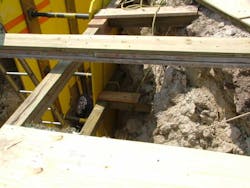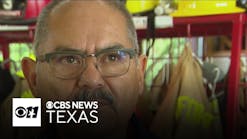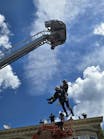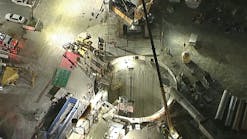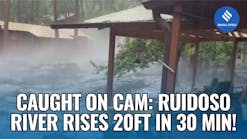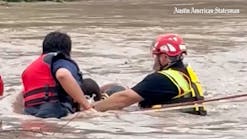We have discussed trench-rescue operations in past articles, including discussions on parts of the trench, soil classifications and their hazards, hazard identification and shoring and stabilizing operations. This month, the focus is on dealing with extreme situations that would require significant shoring and additional patient entrapment situations. Recently, there have been a significant amount of trench collapses that have been making headlines, and some of them have occurred during training events as well (see Photo 1). Moreover, large objects have been involved in the collapse, adding an additional concern towards victim removal and patient care. We will discuss some specific hazards and risks that can lead to an increased difficulty when dealing with trench-rescue operations.
First and foremost, it is critical for all responders to understand that trench collapses are one of the top causes of death in the construction industry. OSHA reports that the risk for injury and death at trench sites is greater than most any other construction site task. The weight of the soil that collapses onto the victim must be dealt with by the emergency responders. In some cases, the soil along with the shoring material can be the cause of the entrapment, and both will have to be dealt with to remove the victim. When the soil or wall fails, the remaining soil may not be able to direct the compressive forces back into the Earth without supplemental shoring devices, such as outside Waler systems with supplemental shoring equipment (see Photo 2).
Intersecting trenches
Gravity and surcharge loads on soil direct compressive energy back into the Earth. That being said, soil has a natural tendency to compress and push against itself, and surcharge loads can increase this compressive force as well. When the soil is removed as the trench is dug, the remaining side walls want to fall inward due to the lack of compressive strength. When trenches intersect and form corners, this leaves multiple sides of the soil released from compressive forces (see Photo 3). When surcharge loads are placed on top, whether it is from materials and spoil piles placed too close or rescuers working at the edge of the trench, there is a higher potential for failure and secondary collapse during the operations. Safety teams should be constantly accessing the situation for signs of secondary collapse at the trench, such as cracks and fissures (see Photo 4). These cracks usually indicate dryness in the soil and the trench wall lacks the ability to keep the tension in the soil due to lack of moisture, resulting in side wall shears or toppling of soil into the trench. Trenches that have more than one side open have a higher tendency for failure from this condition.
When dealing with an intersecting trench, it is vital to get shoring into place on all open wall surfaces as quickly and efficiently as possible, to direct the forces back into the remaining soil. Once the wall panels are placed into position, pneumatic struts used for cross bracing should be lowered into place and set to a first stage pressure (usually 100 psi) to hold the panels in position, so additional panels can be placed on the other exposed walls (see Photo 5). Once all of the exposed walls are secured with panels and pneumatic shoring, the struts can then be pressurized to the desired pressure, which is determined by a few factors, such as depth and width of the trench, type of soil encountered, the distance between horizontal bracing and manufacturer’s recommendations.
Objects in trenches
Trenches are dug for a variety of reasons, most commonly for utilities and sanitary/catch basin systems installed in the roadways. The materials used for these systems are usually located within close proximity to the trench as it is being dug. When the collapse occurs, these objects can fall into the trench and add an additional entrapment to the victim that the rescue team must contend with (see Photo 6). The type of material the object is made of and the nature of the entrapment it provides will have to be considered to remove the victim from the space.
The overall weight of the object must be calculated in order to determine the most efficient way of lifting it. As a general rule, calculating roughly 150 pounds per cubic foot of reinforced concrete, and 500 pounds per cubic foot of steel, an approximate weight can be determined by multiplying the length of the object by the width of the object and then multiplied by the depth of the object. Once determined, a decision of how to remove the object from the victim can be made. Keep in mind that it may be much easier to dig below the victim to relieve the downward pressure of the object while the object is secured in place. If not, then lifting the object will need to be performed. Consider the use of a sewer vacuum truck to assist in the removal of soil entrapping a victim. These vehicles can remove a significant amount of soil in a short amount of time (see Photo 7). Keep in mind, though, that these vehicles can cause a severe amount of vibrations, and can lead to a secondary collapse. It is possible to keep the vehicle a considerable distance away and still be efficient in soil removal.
It may be possible to lift the object from within the trench. In order to perform this, not only does the object need to be lifted safely, it also needs to be secured while it is being lifted. A lot of space on the trench floor will need to be secured to make this possible. Often, due to the collapse and the materials restraining the victim, rescue teams opt to perform the lift from the top side of the trench, due to available space. There are many ways to perform this including the use of a secure high-point anchor, hydraulic tool lift, and pneumatic air-lifting bags (see Photo 8). Consider the work area around the trench while the walls are being stabilized; if there is a potential for a lifting operation outside the trench, then the location of the lifting operation will have to be identified prior to shoring the trench walls (see Photo 9). Rescuers will have to perform a thorough size-up and assessment for the specific operation, as each incident will have specific situations which will define which tactic should be employed at the incident.
Encumbrances around trenches
An encumbrance can be defined as a significant force or hazard applied to the trench surface from an object within close proximity to the trench. These objects can place a surcharge load in any direction into the trench area, and they must be supported to limit their hazards. The downward compressive force can overcome the surface tension of the trench walls and cause tension cracks and collapses within the trench. Usually, compressive forces can be compensated for with wall panels and horizontal bracing, but the additional forces that are being applied in the vicinity of the trench may overwhelm the soil cohesiveness. Consider a utility pole in the close proximity of the trench; this pole can be placed under stress from multiple directions. Utility wires strung from pole to pole will place a lateral eccentric stress on the top of the pole, while guide/anchor wiring and posts can place multiple directional forces in the trench soil. Having the utility company respond to the incident can bring expertise in determining the best course of action to brace the utility pole and limit the forces being applied to the soil.
Some surcharge loads can traverse through the trench in a perpendicular fashion. Consider utility pipes and related materials that are suspended in the trench; now that the underlying soil has been removed from underneath, there are little to no support for the weight of the pipe or material holding the utility service in place. This can lead to a crack or leak from the pipe into the trench, and can bring additional hazards into the operation (see Photo 10). Often the utilities are supported from the top side by placing wood bracing across the top of the trench and securing the piping to the bracing with rope or webbing.
While much attention has been placed on stabilizing the trench walls, the end of the trench can also collapse and lead to an engulfment situation. Shoring the trench wall can be done by placing a wall panel against the end of the trench and applying horizontal bracing from the Waler cross-bracing to hold the panel in place. Care must be taken to not displace the Waler bracing while securing the end of the trench (see Photo 11). If this is not possible, supplemental bracing can be placed between the Waler horizontal bracing and the wall panel horizontal bracing to enclose the trench box.
Conclusion
Special operations incidents can tax departments and responders based upon their size, complexity and requirements. Trench-collapse rescue operations can add complexity and additional concerns that will need to be addressed to free the victim. These incidents can require a broad base of skill sets, including calculating large loads, lifting and moving operations, cribbing and shoring operations, tunneling and void searching operations, and extrication and disentanglement techniques. Furthermore, each step in the operation must be performed in a rescue arena that has already been compromised from the initial collapse, and has significant potential for secondary collapse. Care must be taken and hazard control must be in place in order to have the best outcome for the incident.
Until next time, stay focused and stay safe.
MICHAEL DALEY, a Firehouse.com Contributing Editor, serves with Monroe Township, NJ, Fire District No. 3 as a lieutenant and serves on New Jersey Task Force 1. He earned the Master Fire Instructor certification from the ISFSI and is an instructor at the Middlesex County Fire Academy where he developed rescue training curriculum. He is a managing member of Fire Service Performance Concepts.
